The NVIDIA GeForce RTX 2080 Ti & RTX 2080 Founders Edition Review: Foundations For A Ray Traced Future
by Nate Oh on September 19, 2018 5:15 PM EST- Posted in
- GPUs
- Raytrace
- GeForce
- NVIDIA
- DirectX Raytracing
- Turing
- GeForce RTX
Power, Temperature, and Noise
With a large chip, more transistors, and more frames, questions always pivot to the efficiency of the card, and how well it sits with the overall power consumption, thermal limits of the default ‘coolers’, and the local noise of the fans when at load. Users buying these cards are going to be expected to push some pixels, which will have knock on effects inside a case. For our testing, we use a case for the best real-world results in these metrics.
Power
All of our graphics cards pivot around the 83-86W level when idle, though it is noticeable that they are in sets: the 2080 is below the 1080, the 2080 Ti sits above the 1080 Ti, and the Vega 64 consumes the most.
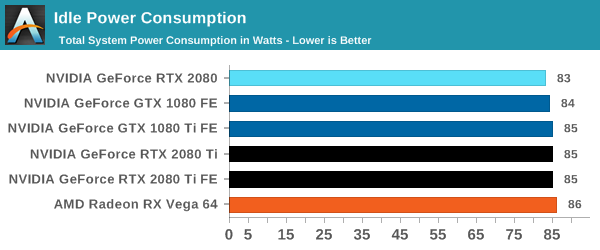
When we crank up a real-world title, all the RTX 20-series cards are pushing more power. The 2080 consumes 10W over the previous generation flagship, the 1080 Ti, and the new 2080 Ti flagship goes for another 50W system power beyond this. Still not as much as the Vega 64, however.
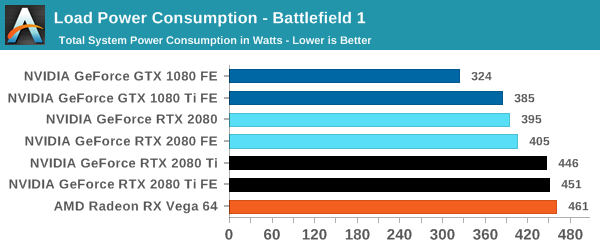
For a synthetic like Furmark, the RTX 2080 results show that it consumes less than the GTX 1080 Ti, although the GTX 1080 is some 50W less. The margin between the RTX 2080 FE and RTX 2080 Ti FE is some 40W, which is indicative of the official TDP differences. At the top end, the RTX 2080 Ti FE and RX Vega 64 are consuming equal power, however the RTX 2080 Ti FE is pushing through more work.
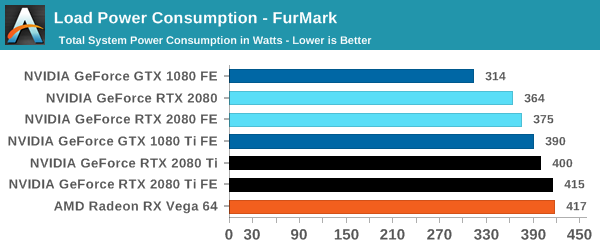
For power, the overall differences are quite clear: the RTX 2080 Ti is a step up above the RTX 2080, however the RTX 2080 shows that it is similar to the previous generation 1080/1080 Ti.
Temperature
Straight off the bat, moving from the blower cooler to the dual fan coolers, we see that the RTX 2080 holds its temperature a lot better than the previous generation GTX 1080 and GTX 1080 Ti.
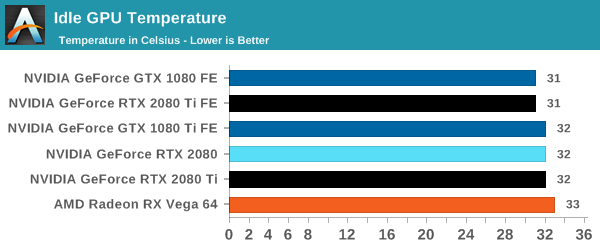
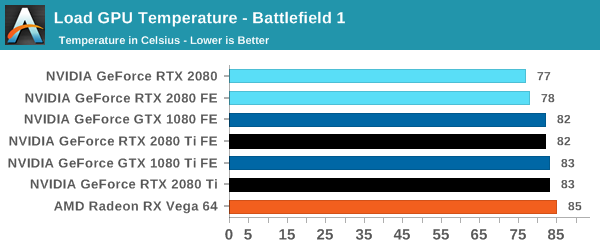
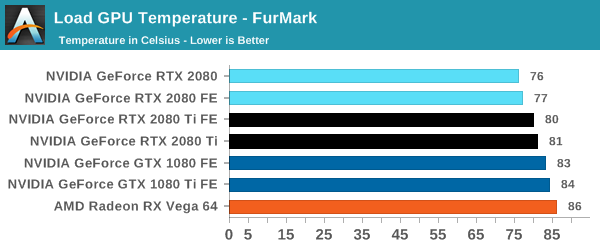
At each circumstance at load, the RTX 2080 is several degrees cooler than both the previous generation and the RTX 2080 Ti. The 2080 Ti fairs well in Furmark, coming in at a lower temperature than the 10-series, but trades blows in Battlefield. This is a win for the dual fan cooler, rather than the blower.
Noise
Similar to the temperature, the noise profile of the two larger fans rather than a single blower means that the new RTX cards can be quieter than the previous generation: the RTX 2080 wins here, showing that it can be 3-5 dB(A) lower than the 10-series and perform similar. The added power needed for the RTX 2080 Ti means that it is still competing against the GTX 1080, but it always beats the GTX 1080 Ti by comparison.
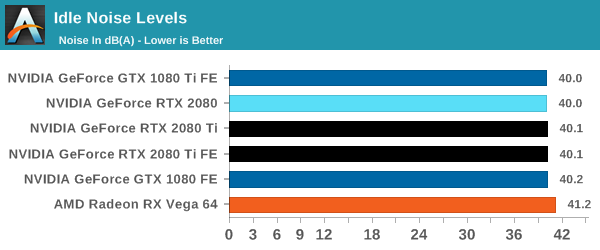
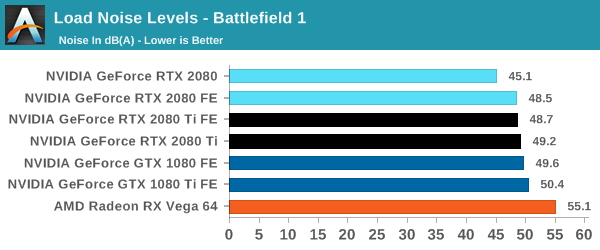
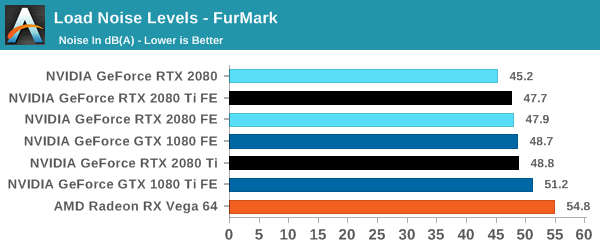










337 Comments
View All Comments
Qasar - Friday, September 21, 2018 - link
burntmybacon just like popinfresh, i guess you will never understand the concept of " no competition, we can charge what ever we want, and people will STILL buy it cause it is the only option if you want the best or fastest " it has NOTHING to do with knowing cost info or what a companies profit margins are... but i guess you will never understand this as welleva02langley - Thursday, September 20, 2018 - link
Once again, not AMD fault if Nvidia is trying to corner AMD with new hardware gimmicks like physix, and charging the customers.You never intended in buying an AMD card anyway, you just want a more affordable Nvidia solution. Guess what, pay for it or leave it.
Even by earning 100K a year, I refuse to pay the gimmick tax. I will buy Navi at release. Screw Nvidia.
V900 - Wednesday, September 19, 2018 - link
What a cool piece of technology!Raytracing would be amazing to have in games, and it really is the future of gaming. Its crazy to think there will be games with it already next year. (And some later this year!)
Is it too expensive? Meh, we are talking about TWENTY BILLION transistors squeezed into the area of a postage stamp.
People pay 600-1000$ for a phone, and some have no problem paying 1000$ for a CPU or a designer chair.
7-1200$ isn’t an unreasonable price for a cutting edge GPU that’s capable of raytracing and will be fast enough for the newest games for years to come.
imaheadcase - Wednesday, September 19, 2018 - link
Did that nvidia check cash they sent you to promote the items yet?shabby - Wednesday, September 19, 2018 - link
Definitely a shill, its too obvious.tamalero - Thursday, September 20, 2018 - link
Theres way too many here defending nvidia just because "its a huge chip".That means nothing for the consumer. We're not buying SIZE, we're buying PERFORMANCE AND FEATURES.
mapesdhs - Wednesday, September 26, 2018 - link
Some of the pro-RTX posts sound more like basic trolling though, just to stir things up. If they're getting paid to post +ve stuff, they're doing a pretty rotten job of it. :DformulaLS - Wednesday, September 19, 2018 - link
Your comments sounds like a paid ad. There is no decency excuse for the prices they are charging.DigitalFreak - Wednesday, September 19, 2018 - link
He has a point. People are willing to pay $1000 for a phone, $1000 for a CPU, but $1000 for a high end graphics card is outrageous? I wish the pricing was cheaper, but I'm not having a fit over it. If people don't want to pay the price, they won't. If Nvidia doesn't sell the numbers they want, they'll probably cut the price somewhat.Fritzkier - Wednesday, September 19, 2018 - link
The $1000 phone actually had more technological advancement... And it's an SoC not individual parts...About a $1000 CPU, it's normal because it's enthusiast product (e.g. Threadripper or i9). There's no $1000 i7 or Ryzen 7...
Nvidia shouldn't have made 2080 Ti. They should've made Titan Turing or something...